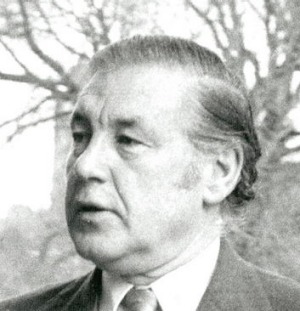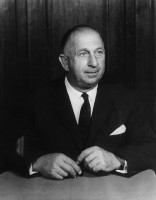
The Democratic Labor Party (DLP) was an Australian political party. The party came into existence following the 1955 ALP split as the Australian Labor Party (Anti-Communist), and was renamed the Democratic Labor Party in 1957. In 1962, the Queensland Labor Party, a breakaway party of the Queensland branch of the Australian Labor Party, became the Queensland branch of the DLP.

Sir Rupert James Hamer,, also known as Dick Hamer, was an Australian politician who served as the 39th premier of Victoria from 1972 to 1981, and prior to that, the 18th deputy premier of Victoria from 1971 to 1972. He held office as the leader of the Victorian division of the Liberal Party of Australia (LPA) and a member of the Victorian Legislative Assembly (MLA) for the division of Kew.

Sir Henry Edward BolteGCMG was an Australian politician who served as the 38th premier of Victoria from 1955 to 1972. He held office as the leader of the Victorian division of the Liberal Party of Australia (LPA) and was a member of the Victorian Legislative Assembly (MLA) for the division of Hampden from 1947 to 1972. He is the longest-serving premier in Victorian state history, having been in office for over 17 consecutive years.

John Cain was an Australian politician, who became the 34th premier of Victoria, and was the first Labor Party leader to win a majority in the Victorian Legislative Assembly. He is the only premier of Victoria to date whose son has also served as premier.
Allan Clyde Holding was an Australian politician who served as Leader of the Opposition in Victoria for ten years, and went on to become a federal minister in the Hawke government.

Sir Albert Arthur Dunstan, KCMG was an Australian politician who served as the 33rd premier of Victoria from 1935 to 1945, and previously as the 3rd deputy premier of Victoria for five days in March 1935. A member of the Country Party, now the National Party, his term as premier was the second-longest in the state's history and the longest of any third-party premier. He was the first person to hold the office of premier in its own right, and not an additional duty taken up by the Treasurer, Attorney-General or Chief Secretary.

Thomas Tuke Hollway was the 36th Premier of Victoria, and the first to be born in the 20th century. He held office from 1947 to 1950, and again for a short period in 1952. He was originally a member and the leader of the United Australia Party (UAP) in Victoria, and was the inaugural leader of the UAP's successor, the Victorian division of the Liberal Party, but split from the Liberals after a dispute over electoral reform issues.

The 1992 Victoria state election, held on Saturday, October 3. was for the 52nd Parliament of Victoria. It was held in the Australian state of Victoria to elect all 88 members of the state's Legislative Assembly and 22 members of the 44-member Legislative Council.

The 1988 Victorian state election, held on Saturday, 1 October 1988, was for the 51st Parliament of Victoria. It was held in the Australian state of Victoria to elect all 88 members of the state's Legislative Assembly and 22 members of the 44-member Legislative Council.

Elections were held in the Australian state of Victoria on 15 July 1961 to elect the 66 members of the state's Legislative Assembly and 17 members of the 34-member Legislative Council. MLAs were elected for three year terms and MLCs were elected for six year terms. All were elected in single-member districts or provinces using preferential voting.
The Bolte Ministry was the 58th Ministry of the Government of Victoria, and was led by Liberal Premier Sir Henry Bolte. It succeeded the Cain ministry on 7 June 1955, following the defeat of the Labor government at the 1955 election held ten days earlier. The ministry lasted over 17 years and was followed by the Hamer Ministry on 24 August 1972 after the resignation of Bolte from politics.
This is a list of members of the Victorian Legislative Assembly from 1952 to 1955, as elected at the 1952 state election.

Elections were held in the Australian state of Victoria on 27 June 1964 to elect the 66 members of the state's Legislative Assembly and 17 members of the 34-member Legislative Council. The Liberal and Country Party (LCP) government of Premier Henry Bolte won a fourth term in office.
Patrick Leslie Coleman CBE, Australian politician, was a member of the Victorian Legislative Council for Melbourne West Province representing the Labor Party from October 1943 until March 1955. He was a member of the Catholic Social Studies Movement in Victoria, and was expelled from the ministry and the ALP as part of the Australian Labor Party split of 1955. After his expulsion from the ALP in March 1955, he became, with Bill Barry in the Victorian Legislative Assembly, the parliamentary leader of the Australian Labor Party (Anti-Communist), which was briefly referred to in the media as the Coleman-Barry Labor Party. He was a member of that party only until June 1955.
William Peter Barry was a Member of the Victorian Legislative Assembly for the Electoral district of Carlton from July 1932 until April 1955. Barry was a member of the Labor Party until March 1955, when he was expelled from the party as part of the Australian Labor Party split of 1955. He became, with Les Coleman in the Victorian Legislative Council, joint leader of the Australian Labor Party (Anti-Communist), a party that in 1957 became the Democratic Labor Party.
The Australian Labor Party split of 1955 was a split within the Australian Labor Party along ethnocultural lines and about the position towards communism. Key players in the split were the federal opposition leader H. V. "Doc" Evatt and B. A. Santamaria, the dominant force behind the "Catholic Social Studies Movement" or "the Movement".
The Third Cain Ministry was the 57th ministry of the Government of Victoria (Australia). It was led by the Premier of Victoria, John Cain of the Labor Party. The ministry was sworn in on 17 December 1952, and resigned on 7 June 1955 when it was succeeded by the Bolte Ministry.

Major Sir Thomas Karran Maltby was a politician in Victoria, Australia. He was a member of the Victorian Legislative Assembly for nearly 32 years from 1929 to 1961, served in several ministries and was Speaker of the assembly from 1947 to 1950.
The Victorian Labor Party, officially known as the Australian Labor Party and commonly referred to simply as Victorian Labor, is the Victorian state branch of the Australian Labor Party (ALP). The branch is currently the ruling party in the state of Victoria and is led by Jacinta Allan, who has served concurrently as premier of Victoria since 2023.

The Victorian Liberal Party, officially known as the Liberal Party of Australia (Victorian Division) and branded as Liberal Victoria, is the state division of the Liberal Party of Australia in Victoria. It was formed in 1944. It became the Liberal and Country Party (LCP) in 1949, and simplified its name to the Liberal Party in 1965.












